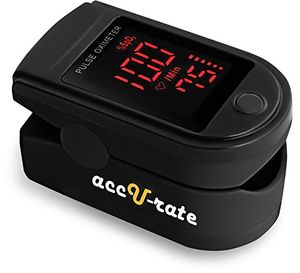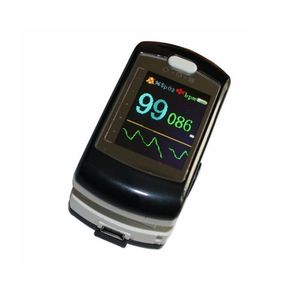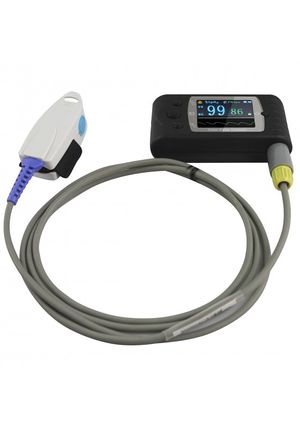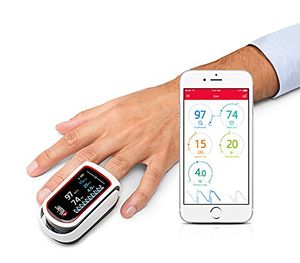Pulse Oximeter
A Pulse Oximeter is a device for checking how much oxygen is in your blood (Blood Oxygen Saturation or SpO2). They work by shining two different colored lights through your finger and seeing how much of each color is absorbed. A healthy person at sea level should have a SpO2 of 96-99%. A pulse oximeter is primarily used in Altitude Training or when traveling to altitude, but it is also handy for measuring Resting Heart Rate. If you have any concerns with possible Sleep Apnea, a pulse oximeter than can record your overnight oxygen saturation may be valuable.
Contents
[hide]1 Getting an Accurate Reading
Because a Pulse Oximeter is indirectly measuring SpO2 via the light traveling through your skin, there are a number of factors that can impact the accuracy of the reading.
- Fingernail polish. Any polish or covering over the fingernail can create problems for the Pulse Oximeter. If you can use a finger that is clear, that is ideal, but you can twist the Pulse Oximeter sideways to get a reading across the finger rather than down through the nail.
- Skin color. Dark skin pigmentation can result in an over-estimated SpO2 reading when it the levels are below 80%. Try to find an area of lighter skin color if possible.
- Movement. Any movement tends to disrupt the measurement, so stay as still as possible. Most devices will give some indication of your pulse, and this can be used to check how well it's detecting your oxygen saturation level.
- Bright lights. A good Pulse Oximeter will tend to shield out any external light, but try to keep light levels reasonably low and avoid shining a light onto the Pulse Oximeter.
- Carbon monoxide poisoning. The pulse Oximeter will show the overall saturation of the blood, without telling the difference between oxygen and carbon monoxide.
- Blood insufficiency. Low blood volume, anemia or poor circulation can all cause problems with the reading.
2 Positioning the Oximeter
These pulse oximeters can be positioned on the finger or the toe. While the toe is the most accurate location[1] there is a delay in the reading[2] that makes it unsuitable for Intermittent Hypoxic Exposure. For overnight recording, it would be nice to have an ear lobe based pulse oximeter, but I've not been able to locate one at a reasonable price.
3 Recommended Pulse Oximeters
I have four pulse oximeters that I recommend. There are from CMS; the 500DL is cheapest but has no recording capability, the more expensive 50E and 60C can interface with a PC via USB and will record data, and the really expensive Masimo MightySat will record via Bluetooth to a smartphone.
- For travelling to altitude, checking Resting Heart Rate without any recording capability, get the CMS 500DL.
- For Altitude Training or recording data overnight, get the CMS 50E or CMS 60C.
- If you want the best quality consumer grade Pulse Oximeter, consider the Masimo MightySat.
3.1 CMS 500DL
This is one of the cheapest pulse oximeters I found, and provides the basic functions adequately. It will display current SpO2 and Heart Rate, and is easy to use. It doesn't have the more advanced features of the CMS-60C or CMS-50E, such as values overnight or interfacing to a computer, but I've found them to be reasonably accurate. I use a similar pulse oximeter to record my Resting Heart Rate each morning. Error: Could not parse data from Amazon!. This pulse oximeter is also available as the CMS 500D (no 'L') that has an alarm for heart rate and/or oxygen saturation Error: Could not parse data from Amazon!.
3.2 CMS-50E
The CMS-50E is similar to other pulse oximeters, being a compact unit the fits on the fingertip. It provides a full color display, but this may not be so easy to read in bright light as a simple red LED. This pulse oximeter will record data overnight on its internal storage, which can then be uploaded to a PC for analysis. I created my Hypoxic Timer software to work with this pulse oximeter, and found it to be a good choice for Intermittent Hypoxic Exposure training. Error: Could not parse data from Amazon!. There is a CMS-50D+ that may also work with the Hypoxic Timer, but I've not tested it Error: Could not parse data from Amazon!.
3.3 CMS-60C
The CMS-60C has an unusual form factor, with the fingertip sensor connected to the main body of the device via a cable. This reduces the weight on your fingertip, and can reduce motion artifacts a little. I find this makes it much easier to use for Altitude Training as there is little weight on the fingertip. Like the CMS-50E, the 60C can record data to internal storage and uploaded for analysis to a PC. The CMS-60C sensor is also easily replaceable, which is nice. Unfortunately, this pulse oximeter is not available from Amazon, only clinicalguard.com.
4 Masimo MightySat
The MightySat is a far more expensive pulse oximeter, and will interface to a smart phone via Bluetooth. Pulse oximeter itself will record data, but to the smart phone app will. This pulse oximeter also displays a value for perfusion index, which is a measure of how good the blood flow is to your finger. While the MightSat is a far nicer device than the other pulse oximeters, its price is rather outrageous and I don't believe it is significantly more accurate than the other devices. Error: Could not parse data from Amazon!.
5 References
- Jump up ↑ NareshKumar Aggarwal, Jyotirmoy Das, Amit Aggarwal, Pulse oximeter accuracy and precision at five different sensor locations in infants and children with cyanotic heart disease, Indian Journal of Anaesthesia, volume 54, issue 6, 2010, pages 531, ISSN 0019-5049, doi 10.4103/0019-5049.72642
- Jump up ↑ EA. Hamber, PL. Bailey, SW. James, DT. Wells, JK. Lu, NL. Pace, Delays in the detection of hypoxemia due to site of pulse oximetry probe placement., J Clin Anesth, volume 11, issue 2, pages 113-8, Mar 1999, PMID 10386281
- Category:Advanced
- Category:Review



